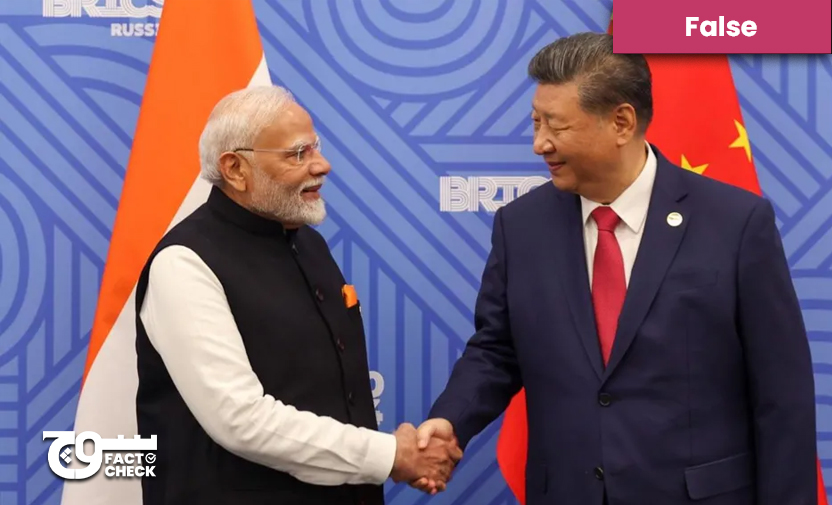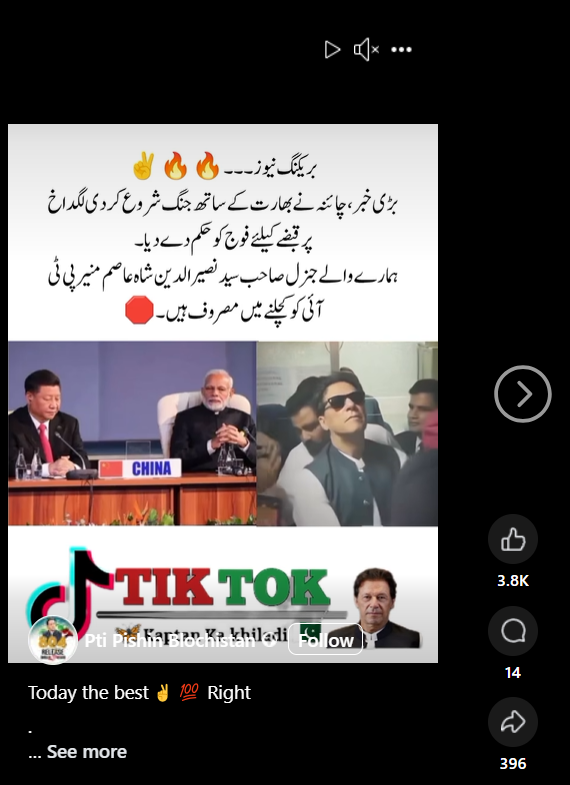
Claim 1: China initiated a war with India, ordering its military to seize control of Ladakh.
Following the recent attack in Pahalgam in Indian-administered Kashmir, a video (archive) was shared on YouTube featuring an image of Indian Prime Minister Narendra Modi and Chinese President Xi Jinping, along with a clip of Imran Khan. It included the following text: “بریکنگ نیوز ۔۔۔
بڑی خبر ، چائنہ نے بھارت کے ساتھ جنگ شروع کر دی لگداخ پر قبضے کیلئے فوج کو حکم دے دیا۔
ہمارے والے جنرل صاحب سید نصیر الدین شاہ عاصم منیر پی ٹی آئی کو کچلنے میں مصروف ہیں۔”
[Translation: Breaking news
China has started a war with India, ordering its military to seize control of Ladakh.
Meanwhile, our own General, Syed Nasiruddin Shah Asim Munir, is busy crushing PTI.]
The claim was also shared on Facebook, however, the post has since been removed.

Claim 2: In response to India’s suspension of the Indus Waters Treaty with Pakistan, the Chinese Foreign Minister delivered a strong diplomatic warning to the country, terminating the Chilkamal Agreement and halting the flow of river water into India.
Claim 3: China is preparing to block the flow of all its rivers into India in response to India’s suspension of the Indus Waters Treaty.
Fact 1: The claim is false. China has not issued any official statements or directives indicating any intent to go to war with India. There are no credible news reports suggesting this either.
Fact 2 and 3: The Chinese government has not suspended the Chilkamal agreement. It has not halted or announced plans to block the flow of its rivers to India either.
Pahalgam attack
On 23 April 2025, a militant attack in Pahalgam, a popular tourist destination in Indian-administered Kashmir, resulted in the deaths of 26 tourists and injuries to 17 others. Initially, several news outlets reported that The Resistance Front (TRF) claimed responsibility for the attack but that the claims were unverified. The little-known militant group is considered an offshoot of the Pakistan-based Lashkar-e-Taiba (LeT), according to Indian officials as well as the South Asia Terrorism Portal, a Delhi-based think tank.
The militants targeted visitors in the remote Baisaran valley. All those killed were men. Among the victims were Lieutenant Vinay Narwal, an Indian navy officer, Manish Ranjan, an Intelligence Bureau employee, and banker Shailesh Kathaliya. As an immediate response, Indian authorities launched a large-scale manhunt in the areas surrounding the site of the attack.
Pakistan’s foreign ministry responded to the attack by expressing concern at the loss of lives. The Indian government, however, accused Islamabad of supporting cross-border terrorism. Pakistan’s Defense Minister Khawaja Asif later denied these accusations and claimed that it is India, which has interfered with Pakistan’s internal affairs. Foreign Minister Ishaq Dar separately claimed that, “India has not given any evidence. They have not shown any maturity in their response,” and that the response was “non-serious”.
After the attack, India closed a key land border with Pakistan, suspended the Indus Waters Treaty, and barred Pakistan’s citizens from entering under a visa exemption scheme. In a broadcast, Indian Prime Minister Narendra Modi vowed to take the harshest response against the perpetrators of the attack.
In the following days, Pakistan called for a neutral investigation and expressed willingness to cooperate, while emphasising its commitment to peace and sovereignty. Nonetheless, cross-border firing at the Line of Control (LoC) resumed after years of calm. Within Indian-administered Kashmir, Indian forces demolished homes of suspected militants, affecting families and sparking local resentment.
On 26 April, TRF distanced itself from the attack, and stated that an “unauthorised” post by the group on one of their digital platforms, claiming responsibility for the attack, was the result of a “coordinated cyber intrusion.” It asserted that any attribution of the attack to the group was false and “part of an orchestrated campaign to malign the Kashmiri resistance.”
Amid growing tensions between the two countries, the US State Department said it was in touch with both countries and had urged them to work towards a “responsible solution.” US President Donald Trump added that he was close to both countries. He further stated that India and Pakistan have been in conflict over Kashmir for many years and the two countries will resolve the situation one way or another.
In a similar vein, China, a key player in the region, also issued a statement urging the two countries to “exercise restraint” and resolve their differences through dialogue.
Tensions between India and China
A violent clash between Indian and Chinese troops in the Galwan Valley of Ladakh in June 2020 marked the deadliest encounter between the two nations in decades, resulting in the deaths of at least 20 Indian soldiers. The incident, which took place along the disputed Line of Actual Control (LAC), involved brutal hand-to-hand combat without firearms. The region, historically quiet, has seen increased friction due to overlapping territorial claims and infrastructure development, BBC reported, citing an Indian military expert who served as a colonel in the army. The incident triggered military talks between the two sides to de-escalate the situation.
These efforts culminated in the India-China Border Patrol Agreement, announced in October 2024, which aimed to restore pre-2020 patrolling rights in areas like the Depsang Plains and Demchok, and establish buffer zones to prevent further confrontations.
Following the agreement, Indian Prime Minister Narendra Modi and Chinese President Xi Jinping met in October 2024 during the BRICS summit in Russia. Both leaders emphasised the importance of managing disputes and enhancing cooperation to stabilise bilateral relations.
Despite these diplomatic strides, challenges persist. India has maintained the restrictions imposed on Chinese investments after the 2020 clash, citing national security concerns. Additionally, while some troop withdrawals have occurred, both countries maintain military presence in other disputed regions, underscoring the fragile nature of the détente.
The claim we are fact-checking likely circulated on social media against the backdrop of these tensions and the recent militant attack in Pahalgam.
Fact or Fiction?
Claim 1:
Soch Fact Check found the claim dubious as any declaration of war or plans to escalate conflict with India by China would have been widely reported by both global and local news outlets. The absence of such reports raised our suspicions.
We still searched for official statements from the Chinese government indicating an intent to initiate war, but did not find anything.
On the contrary, following the Pahalgam attack, Chinese officials publicly condemned the violence. The Chinese Ambassador to India took to X to express his condolences and opposition to terrorism. China’s foreign ministry spokesperson Guo Jiakun echoed this stance, stating that China strongly condemned the attack and opposed all forms of terrorism. These statements signal stable diplomatic relations between the two neighbouring countries.
It’s worth noting that this claim was posted on TikTok in March, before the Pahalgam attack, further undermining the idea that it is linked to recent events or credible intelligence.
When we reviewed the Facebook page that shared the claim, it did not appear to be a credible or unbiased source of news. Rather, it seemed like a pro-PTI page where the introduction read:, “🔥PTI,Social,Media✌️💪❤️🔥Release,Imran,khan💯”. The page included images of Imran Khan and the PTI flag in both the display and cover photo., A further review of recent posts on the page revealed that most of the content was in support of Imran Khan and PTI as well, confirming that it was moderated by a party supporter.
The page has since been deleted, but it was still live when this fact-check was written. We reviewed the claim as it appeared there and noted its circulation on Facebook.
Soch Fact Check concludes that the claim appears to have circulated in the aftermath of the Pahalgam attack and India’s subsequent actions against Pakistan. However, these developments have not led to any declaration of war between China and India.
Claim 2 and 3:
Soch Fact Check reviewed news reports to verify the context behind the two claims and check whether any Chinese officials had made relevant statements.
While the Chinese Foreign Minister Wang Yi reaffirmed China’s support for Pakistan’s sovereignty and security interests, he did not make any statements about suspending past agreements with India or halting the flow of its rivers to India.
In a call with Ishaq Dar, Wang emphasised China’s support for an impartial investigation into the attack and urged both countries to work toward de-escalation.
During a press briefing on 28 April, China’s foreign ministry spokesman Guo Jiakun, said that “China hopes that the two sides will exercise restraint, meet each other halfway, properly handle relevant differences through dialogue and consultation and jointly maintain regional peace and stability.” He further stated that China welcomed all efforts aimed at stabilising the situation.
These remarks came after India and Pakistan reportedly exchanged gunfire across the Line of Control (LoC) for a fourth consecutive night, ending a period of four years of relative calm on the border.
We also reviewed the account ‘Ishq Zaidi’ that had shared the claim. The account categorised as ‘Public figure’ appears to have been created in support of the jailed PTI chairman.
Additionally, several instances of misleading and false information were also shared on the account. For instance, one post claimed that Saudi Crown Prince Mohammed bin Salman allegedly said that, “Everyone asks us for Riyals, only Imran Khan requested for prisoners.” While the Kingdom released over 2,100 Pakistani prisoners locked up in Saudi prisons upon Khan’s request during his tenure, there is no evidence to suggest that the Crown Prince MBS made the statement.
Given the account’s pattern of sharing false and misleading information, this claim is also likely false.
We also reviewed the X account ‘@NavCom24’, which first shared the claim that China had blocked the flow of its rivers to India. The account’s bio described it as “a running OSINT network reporting on conflicts and strategic developments in South Asia and beyond,” but its listed location was Washington, D.C., which raised doubts about its credibility. A Google search did not yield an official website or associated accounts on other platforms.
We examined the account’s recent posts and found multiple instances of false or misleading content, often lacking background evidence or context. This suggested that the claim was likely false.
Soch Fact Check therefore concludes that China did not announce that it is blocking river flows to India or taking any measures beyond its existing diplomatic support for Pakistan.
Virality
The first claim gained significant traction on Facebook, receiving over 21,000 likes and 1,000 shares. However, the page which initially shared it has since been removed from Facebook.
On YouTube, it was shared here (archive).
The second claim was shared here (archive) on Facebook.
On TikTok, it was shared here.
It was shared here, here, and here on YouTube. Archived here, here, and here.
The third claim was shared here (archive), here (archive) and here (archive) on Facebook.
It was shared here (archive) and here (archive) on X
On Instagram, it was shared here (archive).
Conclusion: The claim that China has initiated war with India and ordered its military to seize Ladakh is false. No credible media outlet has reported such an escalation, and the Chinese government has not released any official statements announcing any such military action. Additionally, China has not suspended the Chilkamal agreement or blocked the flow of its rivers to India.
–
Background image in cover photo: PRESS INFORMATION BUREAU
To appeal against our fact-check, please send an email to appeals@sochfactcheck.com
